Untangling Autism
Autism has as many faces as it has patients. As the frequency of diagnosis burgeons, Brandeis scientists and social scientists work to address the vast range of symptoms and challenges the disorder presents.

Photo/Yunghi Kim
Liane Kupferberg Carter ’76 with her son, Mickey.
by Deborah Halber ’80
In 1994, Liane Kupferberg Carter ’76 and her husband found themselves watching as a team of unsmiling experts at a New York teaching hospital poked, prodded and measured their toddler son, Mickey. Carter, a professional writer, recalled in her blog that, after Mickey had undergone two hours of testing, she “perched forward” to catch the doctor’s words more fully, hoping to hear how adorable her child was, how promising his future. Instead, the doctor told her matter-of-factly, “Don’t expect higher education for your son.”
That bombshell still reverberating in her head, Carter gathered up Mickey, his diaper bag and his stroller and headed for the elevator. A social worker they had met that day waved goodbye. No one seemed to notice that the family had just received life-altering news. The formal diagnosis of autism wouldn’t come until much later, when Mickey was 6, but Carter wrote, “It felt as if we were looking down a dark and endless tunnel.”
Autism and autism spectrum disorders (ASD) are complex developmental brain disorders that include Asperger’s and Rett syndromes, among others. Symptoms range from difficulty in learning language to an inability to understand or empathize with other people’s feelings. Carter and others have observed in autistic children a tendency to fixate on topics such as “Thomas the Tank Engine” or the Titanic with an interest bordering on obsession. Some ASD syndromes are accompanied by mental retardation, others by normal or above-normal intelligence. According to the national organization Autism Speaks, one out of every 110 children — and one in 70 boys — is diagnosed with autism.
At Brandeis, brain experts and social scientists are tackling a full complement of issues related to autism, which affects an estimated 1.5 million individuals in the United States and tens of millions worldwide. Social scientists at the Heller School for Social Policy and Management are collaborating with stakeholders such as government officials, health care professionals and other service providers, as well as families, to analyze programs and services for individuals with autism. In the laboratory, neuroscientists and biologists are studying pathways within the brain affected by genes thought to play a role in autism. They’re exploring neurotransmitter imbalances that may lead to the seizures and atypical responses to sensory stimulation that afflict many autistic individuals.
Provost and Senior Vice President for Academic Affairs Marty Wyngaarden Krauss, Ph.D. ’81, says the current autism-related work at Brandeis is the natural outcome of the university’s decades of dedication to improving the lives of individuals with disabilities.
“Brandeis faculty and students have been interested in disability issues since the 1960s,” says Krauss, the John Stein Professor of Disability Research. “The focus of most of the disability research at the Heller School has been on unmet needs, looking at the life experiences and struggles of individuals with disabilities and their families and searching for ways to improve their daily lives. Autism policy research also dovetails with the interest of Brandeis neuroscientists in the developing brain.”
Of Rats and Men
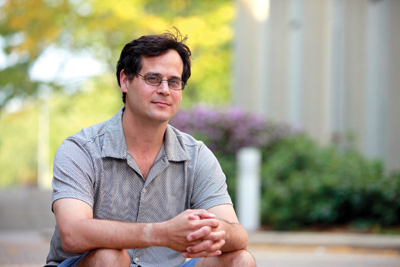 |
Donald B. Katz, associate professor in the Department of Psychology and a researcher at the Volen National Center for Complex Systems, was a clinical psychologist who segued into neuroscience partly because the inner workings of the brain fascinate him. He recalls sitting around the dinner table one night with friends and their 19-year-old autistic son when he noticed the young man’s atypical reactions to faces and touch. How, Katz wondered, do we learn to respond to what we perceive in the outside world?
An expert rat man, Katz thought animal experiments could help elucidate exactly what’s going on in the brain when one individual smiles, another recoils, and a third registers nothing at all in response to the same stimulus. It turns out that the brain system responsible for reactions to chemosensory stimuli in rats is similar to that of humans. Home base for the “fight or flight” mechanism, a brain structure called the amygdala, also helps form and store memories of tastes, smells and other sensory input associated with emotional events. These are exactly the kind of stimuli that seem to be processed differently by people with autism.
Symptoms range widely among individuals. According to the Autism Society of America, autism affects the normal development of the brain in the areas of social interaction, communication skills and cognitive function. Individuals with autism typically have difficulties in verbal and nonverbal communication, social interactions, and leisure or play activities. In addition, individuals with autism often suffer from allergies, asthma, epilepsy, digestive disorders, persistent viral infections, and feeding and sleeping disorders, and they have difficulty managing sensory input.
Carter recalls that, as an infant, her son Mickey wouldn’t venture off a beach blanket because he didn’t like the feel of sand on his skin. Others are hypersensitive to rough fabrics, caresses, loud noises or certain tastes, leading Katz to suspect something about their amygdala is out of whack. The question is, says Katz, does the autistic individual perceive the stimulus as a bad thing or so much of a good thing that it becomes unbearable to process?
To study emotional reactions in rats, Katz looks at one source of the strongest emotional reactions in a rodent’s world: food. When it comes to tastes, rats are like finicky toddlers: Their preferences are written all over their faces. Instead of candy, researchers give rats sugar and salt solutions to make them lick their lips and emit happy little noises. Quinine and raw cocoa, which are bitter to rat palates, make the creatures gape in disgust and try to spit out the offending morsels with their tongues.
Katz uses two tools to elicit a deeper understanding of the molecular mechanisms at play in rats’ response to tastes: Like humans, rats can learn to like a food they once thought noxious; Katz uses this fact to “push around” the rats’ emotional responses to foods, and thereby to probe more deeply into the possible mechanisms of the autistic responses to faces and sensory stimuli. And by manipulating neurotransmitters to temporarily shut down the amygdala altogether, the researcher can make food invoke no emotional response whatsoever, he says. The latter, in effect, mimics the brain state of an autistic individual who shows no response to human faces and other emotionally laden stimuli. What Katz has shown is that sensory perception is learned — which holds out the hope that inappropriate reactions resulting from faulty brain chemistry or genetic mutations can be unlearned.
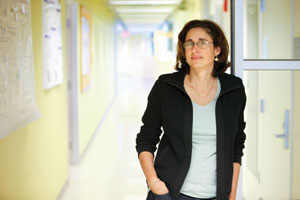 |
In collaboration with Katz, Susan J. Birren, professor of biology and neuroscience, probes how neurotransmitter activity regulates the development of sensory behaviors. Like the Emerald City’s man behind the curtain, the type of neuron Birren studies deep within the center of the brain radiates axons, or nerve fibers, out into the overlying cortex and helps control virtually everything from thought and cognition to behavior and sensory integration, including tastes.
Neurotransmitters are the chemical media through which neuron-to-neuron messages flow. There are dozens of these chemicals; the names of a few, such as dopamine, serotonin and histamine, have made their way into common knowledge. Acetylcholine, while not in the layperson’s lexicon, was the first neurotransmitter discovered. Its roles range from stimulating muscles to regulating REM sleep.
Called “cholinergic” because they release the acetylcholine, the neurons in sensory circuits are involved in attention, arousal and behavior. If cholinergic neurons fail to perform their delicate balancing act in the developing brain, the effects may show up in childhood and linger into adulthood. Loss of cholinergic neurons or disrupted signaling among them has been tied to autism; Rett syndrome, an autism spectrum disorder characterized by seizures and developmental reversals; and Alzheimer’s disease. “It may turn out that monkeying with the basal forebrain — the source of acetylcholine in the cortex and amygdala — changes the perceived intensity of taste stimuli,” Katz comments, “but it’s too early to tell.”
Cerebral Traffic Cops
At the very core of brain function are synapses, the connections through which neurons communicate. There are an estimated hundred billion neurons in the brain and even more connections, all governed by electrical and chemical signals. Some chemical signals are excitatory, Birren explains. “These tell a neuron, ‘Fire, fire, fire!’ while others are inhibitory, saying, ‘Slow down!’” she says.
“The neuron responds to the sum of all the excitatory and inhibitory messages. More excitation results in higher levels of activity in brain circuits and tipping the balance toward inhibition puts on the brakes, but all normal behaviors take place within a certain range of activity. Too much activity and you run the risk of uncontrolled, epileptic-type activity; too little activity and you don’t support cognitive and behavioral processes,” Birren says.
Some researchers believe excitation and inhibition are out of balance in the autistic brain. Birren is attempting to learn how the cholinergic system controls the establishment of that balance during the developmental period in which autistic characteristics first appear in children. “There’s really good evidence that acetylcholine plays an important role in regulating the development and function of brain circuits that control the level of excitation and inhibition in the brain,” Birren says, “but we know relatively little about how this regulation takes place at the levels of cells, genes and molecules. We know from experiments using mouse and rat models that, if the cholinergic system is disrupted, animals develop problems with learning as well as responses to new situations and sensory behaviors.” Through her work with Katz, Birren hopes to shed light on the biologic mechanisms underlying normal behaviors and potentially pinpoint a target for intervention when the process goes amiss.
With the help of a grant in 2004 from the Nancy Lurie Marks Family Foundation, Birren developed and taught for the first time a popular undergraduate class that covers the neurobiology of autism spectrum disorders and their social and policy implications. Called “Autism and Human Development Disorders,” the course takes an interdisciplinary approach to investigate the biological, behavioral, medical and social aspects of autism and other human developmental disorders.
A Missing Genetic Link
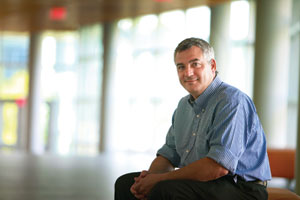 |
Sacha Nelson, professor of biology, looks at Rett syndrome to study the genes that govern excitatory and inhibitory neurons. “The reason we work on Rett syndrome is because it has a lot of symptoms in common with autism — profound cognitive defects, motor problems, seizures — yet at the same time it’s known to be due to a defect in a single gene. Autism could affect tens or hundreds of different genes. It’s a daunting task to study the more general problem of autism and to know what a good animal model is,” Nelson says.
For seven years, Nelson has been researching a gene called MECP2 that binds to DNA and helps regulate gene expression. In both mice and humans, MECP2 kicks in after the nervous system has been formed but continues to grow in response to sensory experience. During this critical period, the brain forms tens of thousands of neuron connections, refining the circuitry that it will use for the rest of its life. “If the process goes awry, it can really screw things up,” Nelson says. People with Rett syndrome often develop normally during the first 18 months, then suffer profound developmental reversals in language, cognition, hand movements and breathing.
“One of the mysteries of these disorders is why autistic patients in general, and Rett syndrome patients in particular, develop seizures,” he says. “The reason is actually counterintuitive — it’s due to a reduction in activity, although you’d think that seizures are caused by too much activity. One hypothesis is that the brain, trying to maintain its delicate balance between too much and too little activity, overcompensates for lowered activity in some regions by increasing it in other regions.” Work on the genes and molecules underlying symptoms such as seizures and hypersensitivity to stimuli could lead to what every parent of an autistic child hopes for: new treatments and perhaps one day a cure.
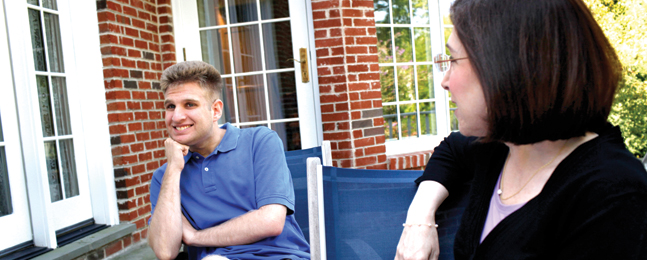
Photo/Yunghi Kim
Liane Kupferberg Carter ’76 with her son, Mickey.
page 2 of 2
Seventeen years after her son’s birth and 11 years after his diagnosis, Carter has not emerged from the “dark and endless tunnel” of autism, although she has learned to navigate it. Carter and her husband, with a referral from a friend who was a therapist, found a national child-development expert who prescribed an extensive course of therapy. Later, the family was introduced to a treatment called applied behavioral analysis (ABA), an intensive therapy that involves breaking down daily behavior into its component parts, which are repeated endlessly with rewards as incentives. Rewards might be as simple as a high five or a pretzel, but Mickey responded so well to ABA that Carter found he was able to sit and focus much longer than he used to — long enough to attend public school. But the next transition — to adulthood — is fraught with a litany of unknowns for teens like Mickey, who may enter a residential program after graduation from high school.
Researchers at the Heller School are working toward helping parents like Carter master the social service system, which includes a dizzying array of health-care specialists, government programs, state-funded initiatives, and school-based services.
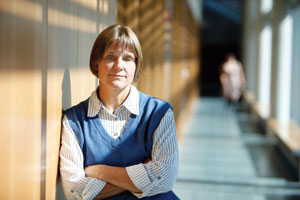 |
Battling the ‘A-word’
“We’re looking at issues across the age spans and across different service systems,” Erickson Warfield says. “The challenge is finding the right mix of services that will meet individual needs in this very heterogeneous population that has a range of intellectual skills and abilities and a range of social skills and abilities as well as potential sensory issues.”
Carter recalls that when Mickey was diagnosed, autism was “the A-word.”
“It was like a death sentence,” she says, recalling the lack of help from hospital experts in putting Mickey’s situation into perspective. Yet as disturbing as it was to hear the “A-word” applied to her son after months of being told Mickey had only a mild speech delay, Carter wishes the diagnosis had come earlier. Had Mickey received a few months of intensive therapy at the critical developmental period before age 2, someone may have “teased more language” out of him, she says.
Today, Erickson Warfield says, there are more support services available for parents receiving that heart-wrenching news. The diagnosis often ends up confirming something parents already suspected. “In some ways, the diagnosis opens up the door to services,” Erickson Warfield says. “The downside is the stigma. Balancing those things is a challenge.”
In the 1990s, as Carter was toting Mickey to expert after expert in the quest to discover the scope of his disability, the hit TV show “St. Elsewhere” featured a nonverbal, classically autistic character. “That and the movie ‘Rain Man’ reflected the images out there for public consumption: savant skills, or a child rocking in the corner unable to communicate,” Carter says. “My kid didn’t fit either image.”
The “classic” case, a child rocking back and forth, unable to make eye contact, is the image the word autism used to bring to mind, Erickson Warfield agrees. Yet there are kids like Mickey, who has always been sunny and affectionate, and there are high-functioning individuals with Asperger’s attending Brandeis and other top-rated universities. “How could you possibly put that range of individuals under the same label?” asks Erickson Warfield.
While national organizations such as Autism Speaks have vastly increased awareness of ASD, parents and families still face a cavalcade of uncertainty about which intervention will be most useful for their child, uncertainty about untested drugs, uncertainty about trustworthy advice. The biggest uncertainty: what the future holds for an aging population that has been likened to victims of an epidemic because of the number of people affected.
Indeed, government statistics suggest that the diagnosis of autism is increasing 10 to 17 percent each year. Erickson Warfield points to better diagnostic tools and more awareness on the part of parents as possible reasons for the rising numbers. At the current rate of growth, the Autism Society of America estimates that the prevalence of autism could reach four million Americans in the next decade.
An Uncertain Future
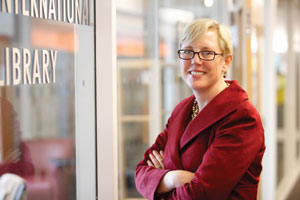 |
|
Susan Parish |
The Carters are intimate with those struggles. With the help of an army of therapists and specialists — Mickey had speech therapy, occupational therapy, sensory integration, physical therapy, vision therapy, auditory integration therapy, behavioral therapy, play therapy, and dietary and biomedical interventions — he learned to read and do math. His language skills have improved by leaps and bounds since his childhood struggles with verb tenses and pronouns. Seizures are mostly controlled by medication. At 17, he still attends public schools. Yet, Carter says, “His future is a big question mark.”
Carter can attest to the fact that the role of parent-advocate doesn’t end as the child approaches adulthood. Neither does the emotional roller coaster.
“Acceptance doesn’t mean giving up, and it isn’t a constant state,” Carter writes in her blog. “Grief and anger still rear up unexpectedly. I still get tired of the relentless effort, the struggle for normalcy, the endless round of therapies and school meetings and fights with the insurance companies.
“Ultimately, what buoys our family is hope. When I look at this child, I do not see ‘autism,’ Carter writes. “I see my child: an animated, endearing, and handsome teenager with a mischievous sense of humor … Parenting this trusting, gentle boy has deepened me immeasurably.”
Deborah Halber ’80 is a freelance writer living in Lexington, Mass.
